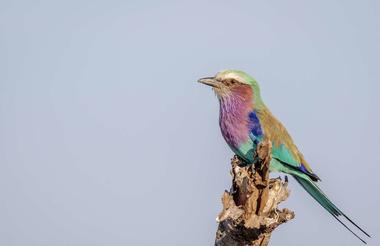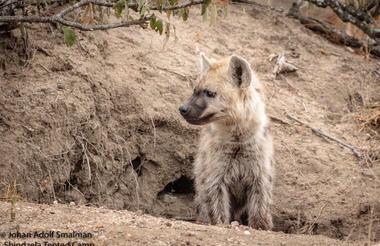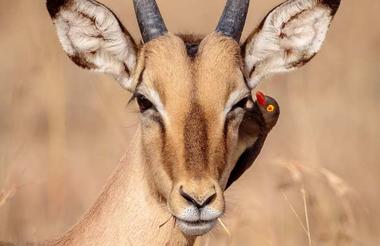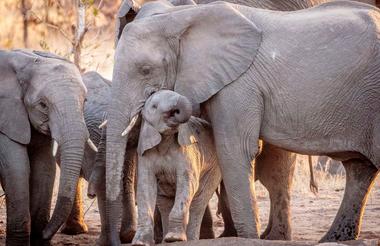You will be met on arrival at Hoedspruit's Eastgate Airport by your photo guide and a transfer representative, and transferred to Shindzela Tented Safari Camp. The transfer will take approximately 1 hour.
Situated within the Timbavati Private Nature Reserve in the Greater Kruger National Park in South Africa, Shindzela offers guests an authentic African wildlife experience. The eco-friendly (solar-powered) and unfenced, a place where one can feel part of the bush.
The safari-style tents are situated under thatch (grass-roof structures) and can be made up as either twin or double-bedded accommodation. Enjoy coffee on your wooden deck, and freshen up in your semi-open en-suite bathroom (shower, WC and handbasin). The camp can accommodate a maximum of 16 guests in total in 8 safari tents. You will be treated to warm South African hospitality in a relaxed atmosphere to enjoy and soak up the true African wilderness.
This afternoon we go out on our first game-drive.
What to bring:
Camera DSLR / mirrorless
Lenses 300 mm or longer
Lens for landscape 16 - 35mm (preferably f2.8) - lenses need lens hoods
Cover for dust and rain
Tripod
4x Memory cards (32 GB or more)
Ideally also bring Laptop with Lightroom and / or Photoshop
Card reader
Lens cleaning kit
Note block and pen
Also important to consider:
Binoculars
Sun block factor 30 or higher
Cap / sunhat
Light walking shoes
Shorts
Swimming costume
Rain jacket
Warm jacket (fleece) - sitting on an open safari vehicle at sunrise can be chilly!
If travelling during winter (April - October), also bring windproof jacket and scarf. It can be very cold early morning and evening on the open safari vehicle!
It is essential that you travel with adequate medical travel insurance, which should also include special medical evacuation cover.



Shindzela is situated in the Timbavati Private Nature Reserve, which is a wildlife-rich concession of land adjoining the western border of the Kruger National Park. The amalgamation of public and private land in the area forms “The Greater Kruger Park” area. There are no fences between the Timbavati and the Kruger National Park,which allows for the free movement of the animals between the Reserves.
This is true “Big Five” territory and the area is home to more than 40 mammal species and 350 types of birds, including large raptor varieties and the famous white lions. Travellers become intrepid adventurers who have an opportunity to spot lion, leopard, elephant, buffalo and rhino on safe, expertly guided excursions. Game viewing is exceptional, with an abundance of elephant, buffalo, kudu, zebra, wildebeest, giraffe, impala, waterbuck and warthog, together with their attendant predators: lion, leopard, cheetah and hyena. The larger and more rare antelopes like Roan, Eland and Tsessebe have been slow to return to the area, but the critically endangered African wild dog is a regular visitor.



Each day at your photo safari lodge will follow more or less this programme (excluding arrival and departure day):
Early morning Wake up with tea / coffees and snacks - Morning game drive: (3 hours)
A photo safari morning starts a little before sunrise! For many, this is a big challenge, but nevertheless imperative, in order to take full advantage of the golden morning light which embellishes most wildlife and nature images. This is also the time of day when most animals are active, so the mornings should give you some great opportunities for capturing striking images. Remember, there is more to wildlife photography than lions; e.g. "the little things"!
An early wake-up call is usually made approximately 30 minutes ahead of departure. This allows for a quick wash and a hot beverage just to get those creative juices flowing….
After a pre-check and briefing by your photo guide (including giving some suggestions for camera settings and a brief over-view of what to expect on the drive), we set off. Your guide is always available on the vehicle to provide constructive suggestions and individual help during the actual drive.
About midway through the morning drive we take a comfort / coffee break in a safe area, to allow guests to stretch their legs and enjoy a hot beverage and some biscuits/rusks etc
Your photographic guide will help you with the camera settings for each specific situation and condition. You need to understand the basic photography terms such as aperture, shutter speed, ISO, metering, drive modes, focus selection points, etc. It is also important to know where and when you should change these settings (with wildlife photography you may miss the special shot if you are fumbling with your camera looking for which button to adjust).
Topics of Importance for Wildlife Photography:
- knowing your subject (the more you know about your subject, i.e. animal, the more likely you are able to predict its whereabouts and actions)
- Getting the shot perfect in the field – without having to do lots of editing in Photoshop afterwards
- using RAW for maximum results
- how and when to use autofocus / manual focus
- controlling Depth of Field
- settings for night (low light) photography
- focusing on the eyes
- know what you want the image to say. Have the images got a special feeling? Do they tell a story?
- composition: Rule of thirds
- use a flash: during day and night
- mastering birds in flight
- importance of supporting your camera
The morning game-drive usually takes about 3 hours (depending on what we see), and we then return to the lodge for a delicious brunch / late breakfast.
Between Breakfast/Brunch and Lunch/High Tea
After breakfast, photo safari guests may retire to a quiet, private corner of the camp to assess the morning results. There will be free time or optional lectures on editing (Photoshop / Lightroom) as well as photography tips and tricks, depending on the group and their preferences. Edit images for the presentation of your best 3 images (which will be held after dinner).
What else? How about read a book, sleep or just sit still and listen to the sounds of raw nature?
Late Lunch / High Tea
We meet again early afternoon for a light meal, before setting off on the afternoon Game Drive (minimum 3 hours). Similar to the morning game drive, we try to find our subjects to photograph. The photo-guide will help you with some tips and tricks for sunset and night photography, and using flash and lights to enhance your shot. Just before twilight, a safe area is located for evening sundowners, where alcohol or soft beverages are served with lights snacks. (Drinks on the drive are usually pre-ordered before the drive sets out).
After sundowners, the guests will experience driving in darkness with a vehicle spotlight to find interesting animals/owls etc, then returning to camp.
Return to lodge after Sunset - Dinner
Time for a quick freshen up before we meet for dinner. Dinner could be a plated dinner, a buffet meal or a traditional African “Braai” (Barbeque) often served in an outside boma around an open fire.
After dinner we meet for maximum 1 hour. We will discuss and evaluate the 3 chosen images per photographer, from the last 2 game drives. These images are displayed for the group to see, with each image being discussed as a group and critiqued by your photo guide. It is NOT a competition, but an opportunity to learn by gaining an understanding of what constitutes a good image.
Bed time: a well-deserved rest after this exciting day in the African Bush. Remember, early start tomorrow!



Four more days to get the special images you so badly want, to improve your photographic skills and to enjoy nature at its best.



Your last morning photo safari drive, followed by breakfast. Transfer to Hoedspruit's Eastgate Airport for your departure.

